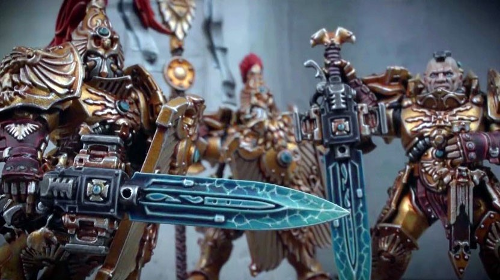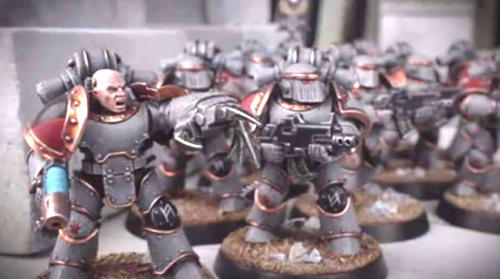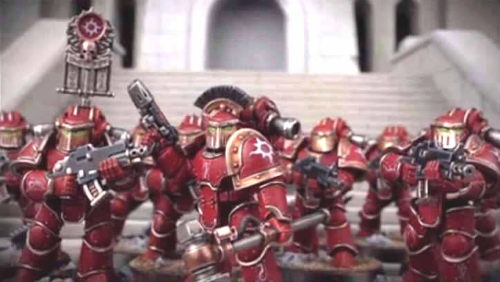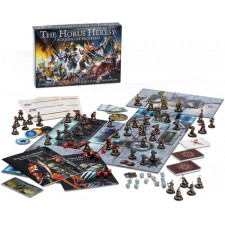Warhammer 40K: Burning of Prospero Review
on Jun 22, 2017
Burning of Prospero is the second Horus Heresy-era board game that Games Workshop has produced, following on from the excellent Betrayal at Calth. Much like its predecessor, this box set packs in lots of Loyalist versus Traitor marine action, but this time on the sorcerous Thousand Sons' homeworld Prospero. The storyline is that the Emperor has sent in the Space Wolves - along with elite Custodian Guard and the anti-psyker Sisters of Silence - to squash the heresy there led by the corrupt Azrak Ahriman. It's a pivotal event in Warhammer history, and this great game puts you right into the thick of the battle among the war-torn streets of Prospero's capital city, Tizca.
Aside from 30 Space Marines in MkIII armor (10 loyalist, 20 traitor), the big draw for Heresy-era fans is going to be the Custodian Guard and Sisters of Silence models. The former are sort of the Emperor's elite personal guard and the latter are an all-female groups of anti-psyker warriors. Of course, they look fantastic and it is always nice to see female units in the overwhelmingly male Warhammer universe. Options abound, and just like with Betrayal at Calth this is a great value for anyone looking to put together a "30k" Space Marine army. Rounding out the set are two awesome hero figures, the Space Wolves' Geigor Fellhand and Ahirman. Both are great centerpiece models with loads of character and detail.

Travis Bickle went on to join the Custodian Guard?
As for the gameplay, I would rate it slightly below Betrayal at Calth if only because it does not continue the really quite awesome, mixed-arms focused tactical combat system from that game. It's an all-new game, and a good one for sure, but I found myself wishing that it were just a bit deeper and more complex. With that said, this is a somewhat simpler and more rambunctious design- but not nearly as over-the-top as Deathwatch: Overkill.
It is scenario based, and all like the best of 40k, these play out almost like you are re-enacting actual historical events. Each takes 30-60 minutes and the gameplay is lightning fast, accessible, and easy to dig right into with a minimum of overhead or bookkeeping. Each turn starts with a psychic phase, during which the Thousand Sons player attempts to cast up to three spells. In order to do so, he or she draws Warp Energy cards while the Space Wolves player tries to counter by drawing Willpower to resist. Once both players have totaled up the card values, the high value succeeds- and there are also some special cards that have additional effects. The spells do a wide range of things that benefit the Thousand Sons player, but you can never count on successfully casting them. This is a heavily luck-driven element of the game which may turn off some, but I find it dramatic and fun.

|

|
Space Wolves versus Thousand Sons- a classic 40k grudge match!
From there, there is a pretty standard movement phase colored by some fairly strict rules for adjacency, pinning, and engagement. Once everything has moved, the combat phase finds players trading off attacks. Each group of units creates a dice pool based on which weapons they have, ranging from d6s to d12s. All of these are rolled against a defense roll (d6 standard, with some units and equipment upgrading to better dice), and then the highest rolls are paired off. The high rolls that are not countered by higher rolls are wounds. Rolls of six or better do double damage as a critical hit, so it nicely models the impact of plasma and other high-impact weapons. It's a really basic system, not quite as interesting as the one in Betrayal at Calth, but there's an old fashioned sense of die-chucking excitement about it that I really enjoy.
Overall, Burning of Prospero is a fun, exciting game that fits right in with the current trend toward Games Workshop excellence. For fans of the lore, it's a total home run with two really awesome forces pitted against each other in a pivotal, compelling battle with several unique units in play. The scenarios are varied and interesting, and the ease of play means that the only real barriers to entry are the price and the modelling aspect. With that said, this set is a tremendous value and overall the models are quite easy to build so even from that angle it remains a good entry point into the 40k world.
I just can't shake the feeling that the game is something of a step backward, but in a sense it's not this game's fault. It's the fault of the game that came before it, which was one of the best games of 2015 and one of the best standalone games that Games Workshop has ever released. But I'm also looking over at my games shelf right now and I wouldn't want to see one of these games but not the other there.

 Customer Support
Customer Support  Subscribe
Subscribe 




 Account
Account  Wishlist
Wishlist 

